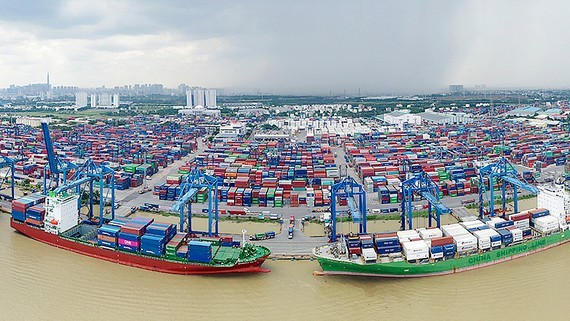 Cat Lai Port in Thu Duc City in HCMC. (Photo: SGGP)
Cat Lai Port in Thu Duc City in HCMC. (Photo: SGGP)
This regulation is fairly simple. Enterprises only need to enter the customs declarations then all data will be synchronized on the system. Infrastructure fees are collected via cashless payment technology. The tracking and linking activities with the parties only need to carry out on the system. The Inland Waterway Port Authority of HCMC supports the connection and sharing of customs declaration and cargo data through the ports to the toll collection system. The Inland Waterway Port Authority of HCMC and the Customs Department can track enterprises that make customs declarations and pay fees through the software.
According to the toll collection scheme, after deducting costs for toll collection, the entire revenues of infrastructure fees will be remitted into the city budget. The Department of Finance cooperates with the Department of Planning and Investment to advise the city to allocate toll revenue for investment and maintenance of transport infrastructure connecting seaports according to the annual proposed category of the Department of Transport, approved by the People's Committee and the People's Council of HCMC. It is expected that the total fee revenues used for infrastructure works, service works, and public utilities in the seaport border gate areas in the 2021-2025 period under the scheme are about VND15 trillion.
On the same day, Deputy Director of HCMC Department of Transport Bui Hoa An said that, from April 1, the city would begin to collect seaport infrastructure fees with the lowest fee of VND15,000 per ton of goods not packed in containers (imported and exported goods that open customs declaration in HCMC), and the highest fee of VND4.4 million per 40-foot container (goods for temporary import for re-export, goods in bonded warehouses, border-gate transfer of goods).
According to the plan, by 2025, 14 infrastructure projects will be implemented using the above revenues. Specifically, Nguyen Thi Dinh Street will be expanded to eight lanes from My Thuy Intersection to Cat Lai Ferry Terminal, with a cost of about VND1.1 trillion; the My Thuy Roundabout will be completed; the Ky Ha 4 Bridge will be newly built; the section of Nguyen Duy Trinh Street from Ring Road 2 to Phu Huu Port will be expanded to 30 meters with investment capital of more than VND800 billion; the route connecting Cat Lai Port to Phu Huu Port will cost about VND950 billion.
According to the toll collection scheme, after deducting costs for toll collection, the entire revenues of infrastructure fees will be remitted into the city budget. The Department of Finance cooperates with the Department of Planning and Investment to advise the city to allocate toll revenue for investment and maintenance of transport infrastructure connecting seaports according to the annual proposed category of the Department of Transport, approved by the People's Committee and the People's Council of HCMC. It is expected that the total fee revenues used for infrastructure works, service works, and public utilities in the seaport border gate areas in the 2021-2025 period under the scheme are about VND15 trillion.
On the same day, Deputy Director of HCMC Department of Transport Bui Hoa An said that, from April 1, the city would begin to collect seaport infrastructure fees with the lowest fee of VND15,000 per ton of goods not packed in containers (imported and exported goods that open customs declaration in HCMC), and the highest fee of VND4.4 million per 40-foot container (goods for temporary import for re-export, goods in bonded warehouses, border-gate transfer of goods).
According to the plan, by 2025, 14 infrastructure projects will be implemented using the above revenues. Specifically, Nguyen Thi Dinh Street will be expanded to eight lanes from My Thuy Intersection to Cat Lai Ferry Terminal, with a cost of about VND1.1 trillion; the My Thuy Roundabout will be completed; the Ky Ha 4 Bridge will be newly built; the section of Nguyen Duy Trinh Street from Ring Road 2 to Phu Huu Port will be expanded to 30 meters with investment capital of more than VND800 billion; the route connecting Cat Lai Port to Phu Huu Port will cost about VND950 billion.
























